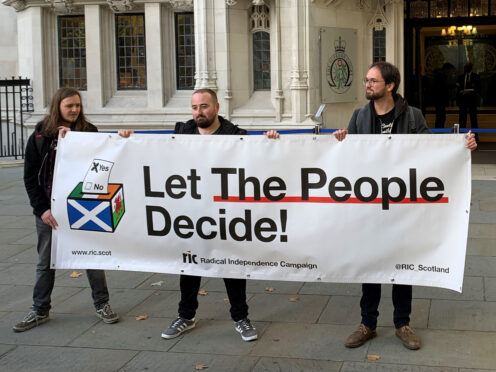
Support for Scottish independence has increased to 56%, a poll has suggested.
A poll from Ipsos Scotland for STV of 1,065 Scots shows support soaring in the wake of the Supreme Court ruling that the Scottish Parliament cannot legislate for a referendum on independence.
With undecided voters ruled out, 56% who were likely to vote said they would back independence in a referendum, while 44% said they would vote against.
When asked when they would like to see a vote on separation, 35% of respondents said before the end of next year, while 26% said they never want another vote, 17% said between 2024 and 2026 and the same proportion said after 2026.
Following the ruling, First Minister Nicola Sturgeon said her party would fight the next general election as a de facto referendum on independence.
The poll also suggested, if the election was being treated as a referendum, the SNP would get 53% of the vote, while the Scottish Greens would receive 2% among those most likely to vote – satisfying the parameters set by the First Minister for negotiations on Scotland leaving the union to begin.
The latest poll from Ipsos Mori which was released this morning has shown the following:
•56% of Scots would support Yes in an immediate #indyref2
•SNP strengthens General Election support to 51%
There is a clear majority of support for Scottish independence among Scots. pic.twitter.com/RDlOyzYCLI
— David Torrance MSP (@DavidHTorrance) December 7, 2022
But when asked for the biggest issues facing Scotland today, 41% of respondents said it was the NHS – up from 27% in the May 2022 poll from Ipsos Scotland – followed by 28% who said the cost of living and 23% who said education.
Scottish independence was fourth at 23% – rising from 17% in the last poll.
The poll also looked at satisfaction with party leaders in Scotland.
The First Minister had a +9 net satisfaction rating, followed by +3 for Scottish Labour leader Anas Sarwar.
Scottish Tory leader Douglas Ross’ net rating was -38, while the Lib Dems Alex Cole-Hamilton was -16.
Scottish Green co-leaders Patrick Harvie and Lorna Slater, who also serve as ministers in the Scottish Government, boasted a net rating of +1 and +2 respectively.
SNP depute leader Keith Brown said the momentum of the campaign for independence was “rocketing” and the poll showed a “clear majority” for separation.
“For too long, Tories and Labour have claimed now is not the time for the people of Scotland to choose their own future,” he said.
“This poll shows clearly the people think now is the time – the Westminster parties need to recognise and respect that.”
“As the chaos of Westminster control wreaks untold damage on Scotland, inflicted by successive Tory governments that we didn’t vote for, it’s no surprise that support for independence continues to rise.
“The only way to protect Scotland is through independence – it is the only way we can get rid of Tory Westminster governments for good.
“No Westminster politician can stand in the way of the Scottish people. To escape the damage of Brexit that both Labour and the Tories back, and to protect Scotland from Westminster governments Scotland doesn’t vote for, we need to choose an independent future.”

Enjoy the convenience of having The Sunday Post delivered as a digital ePaper straight to your smartphone, tablet or computer.
Subscribe for only £5.49 a month and enjoy all the benefits of the printed paper as a digital replica.
Subscribe